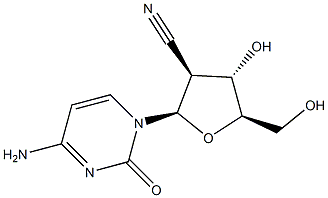4-氨基-1-(2-氰基-2-脱氧-BETA-D-呋喃阿拉伯糖基)-2(1H)-嘧啶酮

4-氨基-1-(2-氰基-2-脱氧-BETA-D-呋喃阿拉伯糖基)-2(1H)-嘧啶酮 性质
| 沸点 | 596.9±60.0 °C(Predicted) |
|---|---|
| 密度 | 1.75±0.1 g/cm3(Predicted) |
| 储存条件 | Store at -20°C |
| 溶解度 | 溶于二甲基亚砜 |
| 酸度系数(pKa) | 12.78±0.70(Predicted) |
4-氨基-1-(2-氰基-2-脱氧-BETA-D-呋喃阿拉伯糖基)-2(1H)-嘧啶酮 用途与合成方法
CNDAC-induced SSBs can be repaired by the transcription-coupled nucleotide excision repair pathway, whereas lethal DSBs are mainly repaired through homologous recombination. Deficiency in two Rad51 paralogs, Rad51D and XRCC3, greatly sensitize cells to CNDAC. The Rad51D-null cell line is approximately 50-fold more sensitive to CNDAC (IC 50 =0.006 µM) compared to 51D1.3, the Rad51D-repleted line (IC 50 =0.32 µM). CNDAC shows inhibitory activity against HL-60 and THP-1 cells with IC 50 s of 1.58 µM and 0.84 µM. CNDAC (10 μM) results in a significant drop in cell survival compared to the untreated on days 4, 7, and 14. CNDAC is more effective at reducing viability and inducing apoptosis than ara-C at equivalent concentrations in the THP-1 cell line, which is defined as displaying resistance to ara-C. CNDAC induces DSBs, which are products of replication, rather than a consequence of induction of apoptosis. CNDAC causes DNA damage, and DNA-PK and ATR are dispensable for cell survival. CNDAC exhibits potent activity against human fibroblasts deficient in ATM or transfected with an empty vector, approximately 30-fold more than cells repleted with full-length ATM cDNA, with IC 50 s of 0.01 μM and 0.3 μM, respectively. CNDAC-induced DNA damage is repaired through the homologous recombination pathway.

